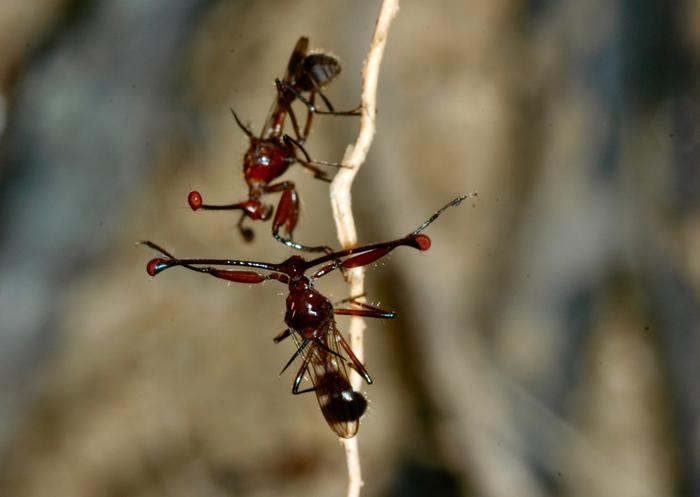Male flies with short eyes make them unattractive by fighting aggressively.

picture:
A conflict between straw-eyed flies. Picture of Gerald Wilkinson.
vision Again
Credit: Gerald Wilkinson
In straw-eyed flies, long eyes attract the ladies. Females prefer males with long eyes, and other males are less likely to fight them for access to females. But some men have a copy of the X chromosome that always causes short eyes. Scientists investigating why this mutation did not die out, regardless of sex selection, found that flies can compensate for their short eyes by being aggressive.
“This is the first time I have noticed that there is evidence of a link between the selfishness gene and aggressive behavior,” said Dr. Josephine Reinhardt of the State University of New York – Geneseo, co-author of the article. Frontiers in Ethology. “These chromosomes that drive the X are very interesting because they are an example of how parts of our genes do not work together, but have their own selfish interests. This is an extreme example, but taking e’ one of these selfish chromosomes affects many aspects of the biology of these animals, even their behavior.”
Swipe left?
There are two different types of X chromosomes present in straw-eyed flies. The X chromosome with a mutation for short drops is a meiotic driver: it has more alleles represented in male sperm, which means there is a greater chance of transmission.
Reinhardt explained: “The driving X chromosome has a great biological advantage because it is based on the correct 50-50 ‘coin flip’ rule of genetics that most of us learned in high school biology. higher,” explained Reinhardt. “Up to 100% of male children end up inheriting X, so they are female. For this reason, we may assume that X will continue to increase in population and cause extinction. Since that hasn’t happened yet, we’re interested in understanding what other factors might interfere with that benefit.”
Male straw-eyed flies protect the opportunity to mate by threatening and fighting. To test whether X-driven flies are more aggressive, scientists used a population of flies carrying either type of X. Flies show more aggression than flies with eyes of the same size, so the researchers they compared contestants with similar eyes, and filmed their contests. and analyze their behavior.
Not only did they find that the fighting behavior was more common when the two flies were very similar in eye size, but that this behavior was more common in males with the X drive. .Men who used these fighting techniques often won competitions. . Scientists have also noticed that men with a dominant X chromosome are more likely to win if they fight more than show off.
Reinhardt said: “When the fighters are not the same, the fights tend to end quickly, and the smaller men retreat. “When a male with an X chromosome fights a male with the same eyes, he is aggressive. and more. But since driving X men on average is smaller, it may still be a problem.”
Flying high
This may explain why flies with short leaves were able to mate. Long eyes indicate a larger body and a more dangerous enemy, which is why flies with short eyes tend to withdraw from competition. If males with the dominant X chromosome are aggressive or misjudge the threat from other males, these males may choose to compete with males with long eyes, in order to mate with females that attract their rivals.
Although this extra aggression can be harmful, it can also help the flies find mating opportunities that they would otherwise not have. However, it cannot fully oppose sexual selection. Modeling the prevalence of car X suggests that this may explain why it has not yet taken off: females still prefer males with long eyes, keeping the frequency of variation low.
Reinhardt warned: “I can say that this study is the first discovery. “A larger study could be done where we specifically test the increase in aggressive behavior that we saw here in a larger sample. Furthermore, this is a laboratory study, so it is not entirely clear whether it would work well. Finally, females were not tested. If the X chromosome increases aggression in females – while it is an indirect effect related to eye stalk size, it may not. it does so.
Journal
Frontiers in Ethology
Research Methodology
An experimental study
Research Topic
Animals
Article Title
Straw-eyed flies that carry the X chromosome compensate for the fight by increasing fighting power
Publication Date of Articles
21-Oct-2024
Definition of COI
The authors declare that the research was conducted without any commercial or financial relationships that could be considered a potential conflict of interest.
Description: AAAS and EurekAlert! are not responsible for the accuracy of the information published on EurekAlert! by participating in organizations or for the use of any information through the EurekAlert system.
#Male #flies #short #eyes #unattractive #fighting #aggressively
